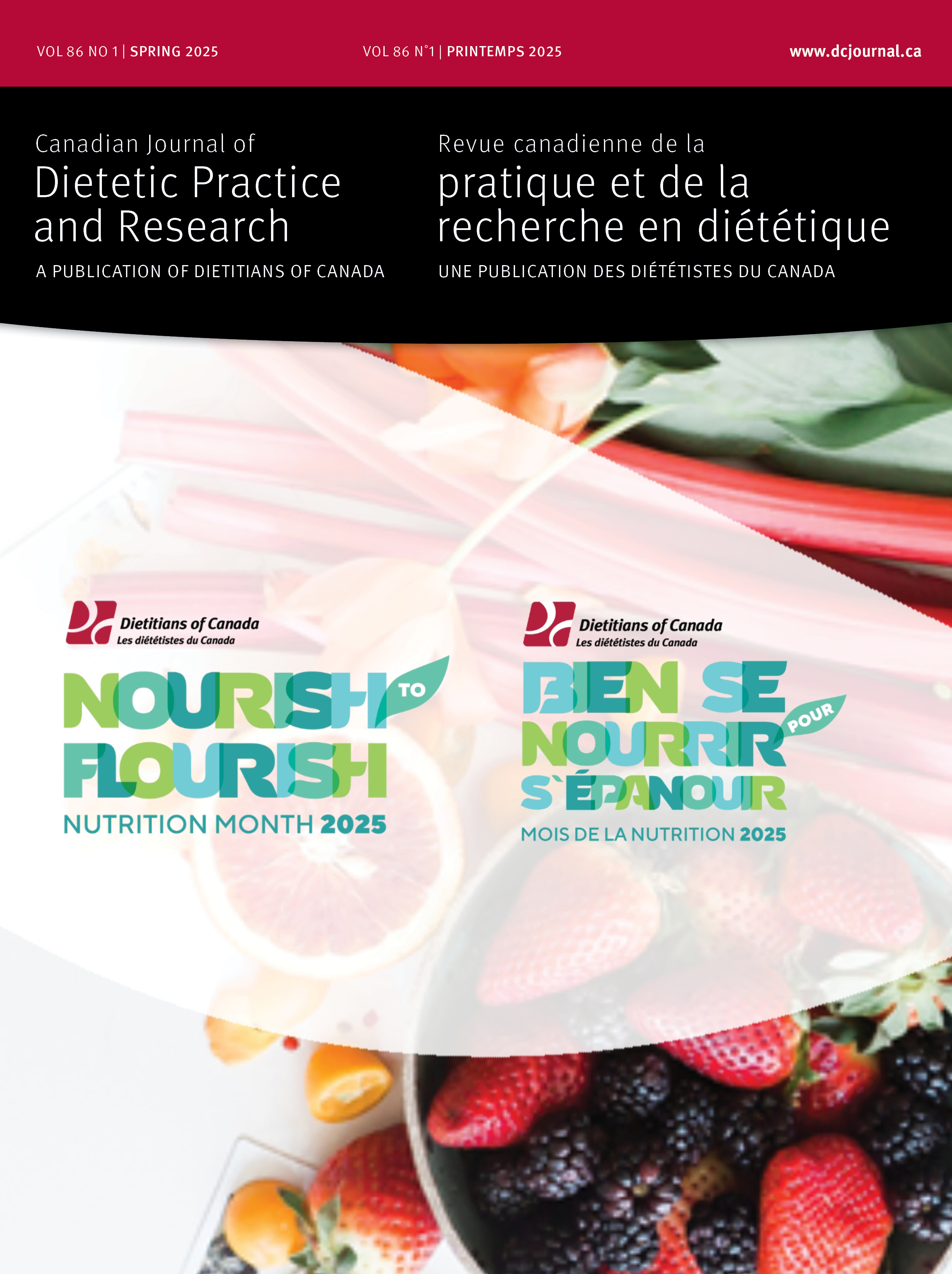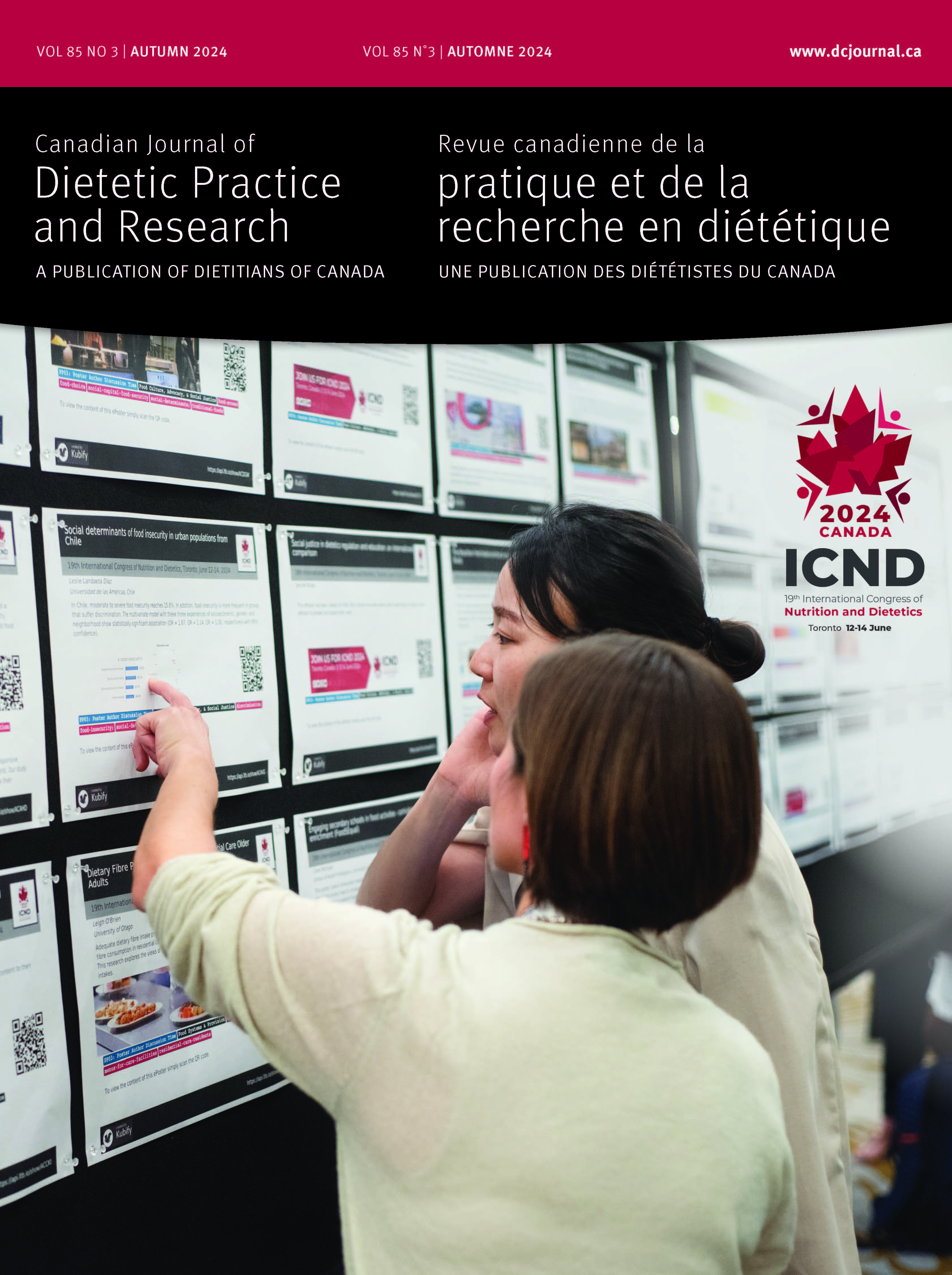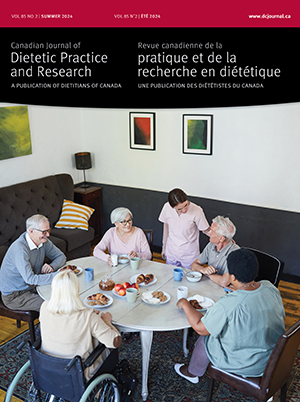Volume 81 • Number 3 • September 2020
Editor’s Message
Research
Purpose: EatRight Ontario (ERO), a multi-modal dietitian service (phone, email, web), provided the public and health intermediaries with healthy eating advice, professional support, and health promotion tools from 2007 to 2018. An evaluation of ERO was conducted to assess the impact of the model on knowledge, attitudes, and behaviour for consumers, utilization, and support levels and satisfaction provided to health intermediaries.Methods: Consumer clients were sent a survey 1–4 weeks after using the ERO service to capture self-reported dietary changes, intentions, nutritional knowledge, and satisfaction. Health intermediaries were recruited through an electronic ERO newsletter and asked about how ERO supported their practice.Results: Of the 867 consumer respondents, 92% had either made a change or indicated that information from ERO confirmed their present behaviour, and 96% indicated they would recommend the services to others. Of the 337 health intermediaries who responded 71% indicated that ERO provided services they could not deliver.Conclusions: ERO’s multi-modal dietitian contact centre provides a model for implementing successful remote service access for consumers and professionals to support healthy eating across diverse demographics and geographies, including those in geographically underserved areas.
Purpose: We explored Registered Dietitians’ (RDs’) perceptions about expressive touch (ET) as a means to provide client-centred care, a practice unreported to date. For this study, ET is defined as relatively spontaneous, responsive, and affective contact by dietitians.Methods: This exploratory study used an explanatory sequential mixed-methods approach. RDs in Northern Ontario were surveyed (54% response, n = 135) and these results were further explored in interviews with a subset of participants (n = 17). Analysis included descriptive and association statistics and qualitative description.Results: Most RDs considered ET a useful tool for effective client communication (66%–77%), yet they were hesitant to enact the practice (81%). Analysis of interviews revealed ET to be “situationally beneficial” with uptake influenced by an interplay of factors, described as: perceived client openness to touch, the environment, and RD comfort with touch. Greater uptake was reported among RDs working with distressed clients and clients in ambulatory clinics and long-term care. ET practice was limited by personal safety concerns, unknown client customs, and client misinterpretation.Conclusion: ET was valued by many RDs as an enhancement to client-centred care. Selective use of ET is influenced by the context of dietetic practice and by perceived client and RD comfort with the use of ET.
Purpose: To explore dietetic practitioners’ perceptions of their education and training in the knowledge, skills, and confidence to understand social justice issues and to engage in socially just dietetic practice and social justice advocacy.Methods: An online semi-qualitative survey sent to Canadian dietitians.Results: Most respondents (n = 264; 81.5%) felt that knowledge- and skill-based learning about social justice and social justice advocacy should be a part of dietetic education and training. Reasons given by respondents for the importance of social justice learning include: client-centred care and reflexive practice, effecting change to the social and structural determinants of health, preventing dietitian burnout, and relevance of the profession. Yet, over half of respondents either strongly disagreed or disagreed that they were adequately prepared with the knowledge (n = 186; 57.4%), skills (n = 195; 60.2%), or confidence (n = 196; 60.5%) to engage in advocacy related to social justice concerns. Some questioned the practicality of adding social justice learning via additional courses to already full programs, while others proposed infusing a social justice lens across dietetic education and practice areas.Conclusions: Dietetic education and training must do more to prepare dietitians to answer calls for dietitians to engage in social justice issues through practice and advocacy.
Perspectives in Practice
Obesity is framed by mainstream media and health care professionals as an “epidemic” contributing to the ill health of the population. This paper reviews literature related to dominant discourses about weight in dietetics, drawing on literature from other health care disciplines, and how these discourses influence patient care. Emerging, competing discourses are also reviewed. Literature highlighted that dietitians and dietetic students are often biased and hold stigmatizing beliefs toward “overweight” and “obese” patients. No research has been conducted in Canada addressing this question, leaving this as an opportunity for future research. Weight stigma and interventions focused on weight have multiple negative implications for individuals, especially those living in larger bodies, including reluctance to seek health care, poor body image, subsequent weight gain, and increased disordered eating. There are alternative discourses emerging, which shift the focus away from weight and toward social justice. The ways in which dietetic students are trained to “manage” weight, and how dominant discourses influence this training, is an important area of future exploration. Dietetic professionals are encouraged to reflect on their weight biases and educate themselves on weight inclusive approaches to health, such as Health at Every Size and Well Now.
Food processing has a unique impact on patients living with chronic kidney disease who may need to restrict dietary sodium, potassium, and phosphorus intake. Canada is the second largest consumer of processed food in the world. Highly processed foods tend to be more nutrient dense, contain less fibre, and are higher in sodium than unprocessed foods. To reduce the amount of sodium in processed food, Health Canada has encouraged food producers to reduce the sodium in their food. Potassium additives have been identified as an attractive alternative to sodium and their use in food processing is expected to increase. Phosphorus additives have been reported to be present in about 44% of processed foods. Given the changes in the nutrient profiles of processed foods, dietary advice on ways to reduce sodium, potassium, and phosphorus intake may be best achieved by recommending minimally processed food and encouraging unprocessed foods more often.
Body changes concerns and body image dissatisfaction are common during pregnancy. We aimed to examine whether health care professionals (HCPs): (i) believe that women are concerned about body image during pregnancy; (ii) consider it important to question, support, and intervene when pregnant women express body image concerns; (iii) feel comfortable enough in their abilities to question pregnant women with concerns; and (iv) have sufficient knowledge and skills to provide adequate support. A 36-item e-survey, developed by ÉquiLibre in collaboration with an expert committee, was sent to HCPs via email. HCPs believe that some situations are associated with body image concerns: postpregnancy weight loss (74.0%), perceived changes in their appearance (65.9%), excessive weight gain (65.3%), and feeling less in control of their body (36.8%). Among 321 responders, 60% considered it important to question pregnant women’s concerns. One in four (25.4%) considered themselves “totally comfortable” asking about weight and body image concerns. Our study showed that HCPs need to be better supported in developing their abilities to help weight-preoccupied pregnant women. There is an urgent need to clarify HCPs’ roles and to delineate the referral process as well as to ensure staff availability, in terms of time and personnel.
Report
OPEN ACCESS
Purpose: The objective was to assess knowledge related to sugars consumption and World Health Organization (WHO) sugars guideline among Canadian dietitians and other health professionals.Methods: A multiple-choice style survey was administered at Dietitians of Canada and Canadian Diabetes Association conferences in 2014.Results: The study showed that only 12% of the surveyed respondents (n = 335) in 2014 were able to correctly identify the amount of added sugars consumed by Canadians, whereas two-thirds overestimated this amount. About 10% of the respondents knew that the 10% guideline by WHO for free sugars was based on evidence related to dental caries. Registered dietitians had relatively better knowledge of Canadian sugars consumption (P = 0.003), but not of the WHO free sugars guideline compared with other surveyed health professionals such as medical doctors or nurses.Conclusions: Knowledge gaps existed among surveyed Canadian health professionals on topics related to sugars consumption and the WHO sugars guideline. Future research should focus on tools to support better communication of sugars guideline and consistent use of sugars terminology.
Purpose: To better understand which plant-derived products contribute to the usual daily total polyphenol content (TPC) intake of Canadian adolescents.Methods: A convenience sample from 2 southwestern Ontario high schools was obtained (n = 108). Students of all gender and ethnicity were invited to participate if they were enrolled in grades 9–12 and were between the ages of 13 and 18 years. To measure the usual intake of TPC found in fruits, vegetables, fruit juices, nuts and legumes, tea, and coffee and coffee-based beverages, participants completed a food frequency questionnaire. TPC of the tea, coffee and coffee-based beverages, and fruit juices were determined spectrophotometrically, and the TPC of all other food items were calculated using the Phenol-Explorer Database.Results: Participants’ median consumption of TPC was 974 mg/day (25th, 75th percentile; 559, 2161, respectively). Fruit contributed 69% to TPC intake with 24% from vegetables; 3% from juice; 2% from tea, coffee, and coffee-based beverages; and 0% from nuts and pulses. No sex differences were found.Conclusion: The results of this exploratory study suggest that fruit is the major contributor to the daily TPC intake of adolescents in Ontario, Canada; however, a larger-scale study is warranted to confirm these findings.
Purpose: To investigate experiences with, and perceptions of, simulation in learning and using the Nutrition Care Process/Terminology (NCP/T) of dietitians in Canada.Methods: In February–March 2017, a convenience sample of 382 dietitians in Canada (71.8% in clinical practice) completed an online survey regarding the type(s), setting(s), and perceptions of the simulations in which they engaged in learning and using the NCP/T.Results: A majority (76.7%) of respondents had engaged in NCP/T-related simulation, most commonly case studies (85.3%) and role-play (42.0%), as part of workplace/volunteer training (51.4%) and undergraduate internship/stage/practicum (34.2%). Nearly half (49.5%) of respondents learned all 4 NCP components via simulation, with Nutrition Diagnosis being the most common individual component (57%). Over three-quarters of respondents agreed/strongly agreed that simulation helped them better understand/use the NCP/T and that NCP/T-related knowledge/skills gained through simulation are transferable to the clinical setting/dietetic practice.Conclusions: Dietitians in Canada perceive simulation to have helped them learn and use the NCP/T. Resources should be directed at further developing simulation for teaching the NCP/T in dietetics education and training. Research investigating characteristics, barriers, and facilitators of effective NCP/T-simulation, using objective (vs. perceived) learning outcome measures is needed.
Canadian Foundation for Dietetic Research
FREE ACCESS
Due to the cancellation of the Dietitians of Canada (DC) conference for 2020 because of the COVID-19 pandemic, the 2020 Research Showcase was not able to be held as planned in Saskatoon in June 2020.Ten of the Early Bird abstracts were presented as Lightning Rounds during the virtual DC conference that was held in June and July, 2020. All 25 Early Bird abstracts are published in this issue of the Canadian Journal of Dietetic Practice and Research and are also posted on the CFDR website. These abstracts represent a wide variety of practice-based nutrition research projects in Canada.The Early Bird abstract research event would not be possible without the commitment and dedication of many people. On behalf of DC and CFDR, we extend a special thank you to members of our abstract review committee: Susan Campisi (University of Toronto); Elaine Cawadias (Retired); Pauline Darling (University of Ottawa); Andrea Glenn (St. Francis Xavier University); Mahsa Jessri (University of British Columbia); Jessica Lieffers (University of Saskatchewan); Shelley Vanderhout (University of Toronto).Thanks also to the moderators for the Lightning Round presentations in the virtual DC conference. Finally, thanks also to the DC Conference team for their support with the Lightning Round presentations over the course of the DC virtual conference.Christina Lengyel PhD RDChair, 2020Early Bird CommitteeAssociate ProfessorDirector of the Dietetics ProgramHuman Nutritional SciencesUniversity of ManitobaJanis Randall Simpson PhD RDFDC FCNSProfessor EmeritaUniversity of GuelphExecutive Director, CFDR










